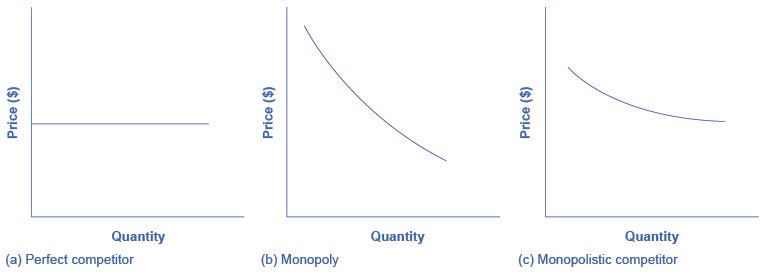Perceived Demand - Monopolistic Competitor
What is Perceived Demand for a Monopolistic Competitor
- Marketing, Advertising, Sales & PR
- Accounting, Taxation, and Reporting
- Professionalism & Career Development
-
Law, Transactions, & Risk Management
Government, Legal System, Administrative Law, & Constitutional Law Legal Disputes - Civil & Criminal Law Agency Law HR, Employment, Labor, & Discrimination Business Entities, Corporate Governance & Ownership Business Transactions, Antitrust, & Securities Law Real Estate, Personal, & Intellectual Property Commercial Law: Contract, Payments, Security Interests, & Bankruptcy Consumer Protection Insurance & Risk Management Immigration Law Environmental Protection Law Inheritance, Estates, and Trusts
- Business Management & Operations
- Economics, Finance, & Analytics
What is Perceived Demand for a Monopolistic Competitor?
A monopolistically competitive firm perceives a demand for its goods that is an intermediate case between monopoly and competition.
The demand curve that a perfectly competitive firm faces is perfectly elastic or flat, because the perfectly competitive firm can sell any quantity it wishes at the prevailing market price. In contrast, the demand curve, as faced by a monopolist, is the market demand curve, since a monopolist is the only firm in the market, and hence is downward sloping.

The demand curve that a perfectly competitive firm faces is perfectly elastic, meaning it can sell all the output it wishes at the prevailing market price. The demand curve that a monopoly faces is the market demand. It can sell more output only by decreasing the price it charges. The demand curve that a monopolistically competitive firm faces falls in between.
The demand curve as a monopolistic competitor faces is not flat, but rather downward-sloping, which means that the monopolistic competitor can raise its price without losing all of its customers or lower the price and gain more customers. Since there are substitutes, the demand curve facing a monopolistically competitive firm is more elastic than that of a monopoly where there are no close substitutes. If a monopolist raises its price, some consumers will choose not to purchase its product—but they will then need to buy a completely different product. However, when a monopolistic competitor raises its price, some consumers will choose not to purchase the product at all, but others will choose to buy a similar product from another firm. If a monopolistic competitor raises its price, it will not lose as many customers as would a perfectly competitive firm, but it will lose more customers than would a monopoly that raised its prices.
At a glance, the demand curves that a monopoly and a monopolistic competitor face look similar—that is, they both slope down. However, the underlying economic meaning of these perceived demand curves is different, because a monopolist faces the market demand curve and a monopolistic competitor does not. Rather, a monopolistically competitive firm’s demand curve is but one of many firms that make up the “before” market demand curve.
Related Topics
- Market Structure
- Perfect Competition
- Bidding War
- Complements & Substitutes
- Substitution Effect
- Imperfect Competition
- Market Power
- Price Takers
- Price Makers
- Perfect Competition and Decision Making
- X-Efficiency
- Captive Market
- Contestable Market Theory
- Highest Profit Point in a Perfectly Competitive Market
- Marginal Revenue
- Using Marginal Revenue and Marginal Costs to Maximize Profit
- Marginal Revenue Curve
- Profit Margin and Average Total Cost
- Break Even Point - Cost Curve
- Shutdown Point - Cost Curve
- Short-Run Decisions Based Upon Costs in a Perfectly Competitive Market
- Marginal Costs and the Supply Curve for a Perfectively Competitive Firm
- Long-Run Average Supply (LRAS)
- Decisions to Enter or Exit a Market in the Long Run
- Long-Run Equilibrium in a Perfectly Competitive Market
- Constant, Increasing, and Decreasing Cost Industries
- Productive and Allocative Efficiency in Perfectly Competitive Markets
- Market Efficiency
- Market Inefficiency
- Pareto Efficiency
- Market Failure
- Search Theory
- Monopoly
- Natural Monopoly
- Legal Monopoly
- Bilateral Monopoly
- Promoting Innovation through Intellectual Property
- Predatory Pricing
- How Monopolists Set Price with the Demand Curve
- Total Cost and Total Revenue for a Monopolist
- Marginal Revenue and Marginal Cost for a Monopolist
- Inefficiency of Monopoly
- Perfectly Competitive Market
- Monopolistic Competition
- Duopoly
- Oligopoly
- Differentiated Products
- Perceived Demand for a Monopolistic Competitor
- Monopolistic Competitors Choose Price and Quantity
- Monopolistic Competitors and Entry
- Monopolistic Competition and Efficiency
- Cartel (Economics)
- Game Theory
- Traveler's Dilemma
- Prisoner's Dilemma
- Iterated Prisoner's Dilemma
- Nash Equilibrium
- Diner's Dilemma
- Trembling Hand Perfect Equilibrium
- Gambler's Fallacy
- Arrows Impossibility Theorem
- Backward Induction
- Tournament Theory
- Oligopoly and the Prisoner’s Dilemma
- Forcing Cooperation in a Prisoner’s Dilemma
- Cooperation and the Kinked Demand Curve
- Corporate Merger or Acquisition
- Antitrust Laws
- Herfindahl-Hirschman Index
- Concentration Ratio
- Other Approaches to Measuring Monopoly Power in an Industry
- Restrictive Practices under Antitrust Law
- Natural Monopoly
- Cost-Plus Regulation
- Price Cap Regulation
- Regulatory Capture